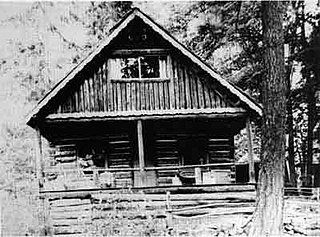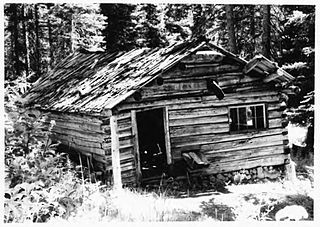
North Cascades National Park is an American national park in the state of Washington. At more than 500,000 acres (200,000 ha), it is the largest of the three National Park Service units that comprise the North Cascades National Park Complex. North Cascades National Park consists of a northern and southern section, bisected by the Skagit River that flows through the reservoirs of Ross Lake National Recreation Area. Lake Chelan National Recreation Area lies on the southern border of the south unit of the park. In addition to the two national recreation areas, other protected lands including several national forests and wilderness areas, as well as Canadian provincial parks in British Columbia, nearly surround the park. North Cascades National Park features the rugged mountain peaks of the North Cascades Range, the most expansive glacial system in the contiguous United States, the headwaters of numerous waterways, and vast forests with the highest degree of flora biodiversity of any American national park.

The Okanogan National Forest is a U.S. National Forest located in Okanogan County in north-central Washington, United States.

Lake Chelan is a narrow, 50.5 mi (81.3 km) long lake in Chelan County, north-central Washington state, U.S. It is an overdeepened lake and resembles a fjord, with an average width of 1.3 mi (2.1 km). Near its upper end, the lake surface lies more than 6,600 ft (2,000 m) below peaks less than 3 mi (4.8 km) away. Before 1927, Lake Chelan was the largest natural lake in the state in terms of both surface area and water volume. Upon the completion of Lake Chelan Dam in 1927, the elevation of the lake was increased by 21 ft (6.4 m) to its present maximum-capacity elevation of 1,100 ft (340 m).

Stehekin is a small unincorporated community in Chelan County, Washington. The name "Stehekin" comes from a word in the Salishan language that means "the way through". Stehekin has about 75 permanent residents, although its population swells during the summer with vacationers and seasonal workers.

The Stehekin River is a river located in Washington state in the Pacific Northwest of the United States. It is the main river flowing into Lake Chelan. Miners arrived in Stehekin River Valley in the late 19th century. They were followed by homesteaders in the early 20th century. Today, the Stehekin River Valley is still a remote area that can only be reached by way of a 55-mile boat ride up Lake Chelan.

Lake Chelan National Recreation Area is a national recreation area located about 35 miles (56 km) south of the Canada–US border in Chelan County, Washington. It encompasses an area of 61,958 acres (25,074 ha) including the northern end of Lake Chelan and the surrounding area of the Stehekin Valley and the Stehekin River. The area is managed by the U.S. National Park Service as part of the North Cascades National Park Service Complex.
Holden Village is a year-round Lutheran Christian center in the North Cascade mountains of the U.S. state of Washington. Formerly the site of one of the largest copper mines in the United States, the Holden mine, Holden is accessible only by the Lake Chelan passenger ferry, the Lady of the Lake, or by hiking in through the Cascade Mountains. Holden Village is the largest retreat center in the nation operating under a special use permit from the United States Department of Agriculture - Forest Service.

Munson Valley Historic District is the headquarters and main support area for Crater Lake National Park in southern Oregon. The National Park Service chose Munson Valley for the park headquarters because of its central location within the park. Because of the unique rustic architecture of the Munson Valley buildings and the surrounding park landscape, the area was listed as a historic district on the National Register of Historic Places (NRHP) in 1988. The district has eighteen contributing buildings, including the Crater Lake Superintendent's Residence which is a U.S. National Historic Landmark and separately listed on the NRHP. The district's NRHP listing was decreased in area in 1997.

The Buckner Homestead Historic District, near Stehekin, Washington in Lake Chelan National Recreation Area incorporates a group of structures relating to the theme of early settlement in the Lake Chelan area. Representing a time period of over six decades, from 1889 to the 1950s, the district comprises 15 buildings, landscape structures and ruins, and over 50 acres (200,000 m2) of land planted in orchard and criss-crossed by hand-dug irrigation ditches. The oldest building on the farm is a cabin built in 1889. The Buckner family bought the farm in 1910 and remained there until 1970, when the property was sold to the National Park Service. The Buckner Cabin was listed on the National Register of Historic Places in 1974. The rest of the Buckner farm became a historic district in 1989. Today, the National Park Service maintains the Buckner homestead and farm as an interpretive center to give visitors a glimpse at pioneer farm life in the Stehekin Valley.

The Buckner Cabin, also known as William Buzzard's Cabin, located about 2.6 miles (4.2 km) northwest of Stehekin, Washington in Lake Chelan National Recreation Area of North Cascades National Park Complex, is one of a group of structures relating to the theme of early settlement in the Lake Chelan area. The original cabin, listed individually as the Buckner Cabin on the National Register of Historic Places, was built in 1889 by Willam Buzzard and altered in 1911 by William and Harry Buckner. The surrounding structures are included in the Buckner Homestead Historic District.

The Golden West Lodge Historic District includes the Golden West Lodge and six log cabins around it in Stehekin, Washington. Built in 1926, the lodge used salvaged portions of the Field Hotel, demolished the same year when the level of Lake Chelan was raised. Located in Lake Chelan National Recreation Area, the lodge was rehabilitated to function as the National Park Service Stehekin District Headquarters and Visitor Center in 2002.

The George Miller House is a rustic log cabin near Stehekin, Washington, United States, in Lake Chelan National Recreation Area. The cabin was built in 1938 and continues to function as a residence.

The Eagle Ranger Station, also known as the Eagle Guard Station and presently known as the Sol Duc Ranger Station, is a complex of three buildings built in the 1930s in what would become Olympic National Park. The primary structures were built by the U.S. Forest Service in what was at the time the Olympic National Forest., While the main residence was built by the USFS, the generating plant and landscaping were built by the National Park Service using labor provided by the Civilian Conservation Corps.

The Graves Creek Ranger Station is a small historic district in Olympic National Park, Washington, USA. It includes the first administrative buildings to be built by the National Park Service in the newly designated park. The district comprises two buildings built in 1939-41 by the National Park Service in the Graves Creek region of the western park. Labor from the Civilian Conservation Corps and the Public Works Administration was used for both the ranger station residence and the garage-woodshed, as well as for a generator building that no longer stands. The 1939 ranger station residence is a one-story frame structure, clad in cedar shingles. The garage is of similar construction, built in 1941. Both structures are examples of the late National Park Service Rustic style, featuring broad shingle courses and deep eaves.

The Backus-Marblemount Ranger Station House No. 1009 is in Mount Baker-Snoqualmie National Forest, in the U.S. state of Washington. Constructed by the United States Forest Service in 1932, the ranger station was inherited by the National Park Service when North Cascades National Park was dedicated in 1968. The ranger station was placed on the National Register of Historic Places in 1989.

The Backus-Marblemount Ranger Station House No. 1010 is in Mount Baker-Snoqualmie National Forest, in the U.S. state of Washington. Constructed by the United States Forest Service in 1933, the ranger station was inherited by the National Park Service when North Cascades National Park was dedicated in 1968. The ranger station was placed on the National Register of Historic Places in 1989.

The Sulphide Cabin, also known as the Frisco Cabin, is a log cabin located along Bridge Creek Trail in North Cascades National Park, in the U.S. state of Washington. Constructed sometime in the 1920s by A.H. Peterson and his nephew, the cabin was a warm season residence used while Peterson worked his mining claim. The cabin was constructed plainly of rounded hewn logs, half notched at the corners. The cabin has two rooms and is 18 by 25 ft with a door at each of the two shorter ends above which rises a gable roof which is wood shingled. Sulphide–Frisco Cabin was placed on the National Register of Historic Places in 1989 as it is the only remaining residence associated with mining in the Stehekin region of the park.

The Golden West Visitor Center is located at the southeast unit of North Cascades National Park Complex in the Lake Chelan National Recreation Area. It sits at the southern end of the small town of Stehekin, Washington and is the only National Park Service visitor center in the southeast unit of the Park Complex. It is the main ranger station for all traffic in and out from the south end of the park via boat, seaplane or by foot from the many hiking trails linking the Stehekin River Valley to the outside world.
Howard Lake, a 15 acres (0.061 km2) lake, and its associated 3 miles (4.8 km) stream, Howard Creek, are located in the Stehekin River Valley in Washington State’s Cascade Mountain Range. They are both within the Lake Chelan National Recreation Area, a part of both the North Cascades National Park Complex and the Stephen Mather Wilderness. Howard Lake is located at Latitude +48.3886007 and Longitude -120.8334497.

McGregor Mountain is an 8,122-foot (2,476-metre) elevation massif located in the Stehekin Valley of the North Cascades, in Chelan County of Washington state. McGregor Mountain is situated northwest of Lake Chelan in the northern Methow Mountains, on the shared border of North Cascades National Park and Lake Chelan National Recreation Area. The closest community is Stehekin, and the nearest higher neighbor is Goode Mountain, 7.3 miles (11.7 km) to the northwest. Precipitation runoff from the mountain drains into tributaries of the Stehekin River. Topographic relief is significant since the southern aspect of the mountain rises 6,600 feet above this river in approximately two miles. The famous Pacific Crest Trail traverses the western base of this mountain, and the strenuous 7.7-mile (12.4 km) McGregor Mountain Trail gains 6,400 feet of elevation to take hikers within a half-mile of the summit. Reaching the summit requires exposed scrambling the final 1,100 feet, and an ice axe is needed if the trail remains covered by snowpack. The summit was the site of an old fire lookout cabin from 1923 until 1955, but now has a radio repeater for the National Park Service. The views from the top include Glacier Peak, Black Peak, Corteo Peak, Frisco Mountain, Tupshin Peak, Dome Peak, Glory Mountain, and many others. This mountain was named for Billy McGregor, a Stehekin Valley resident who had a cabin and homestead at the base of this mountain during the 1890s. In May 1901, Billy disappeared overnight from a boat docked in Lake Chelan, and was never seen or heard from again.



















